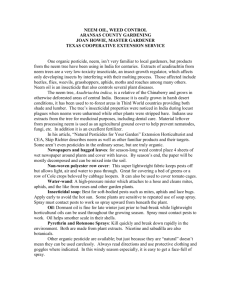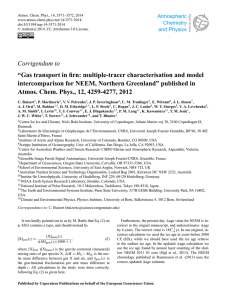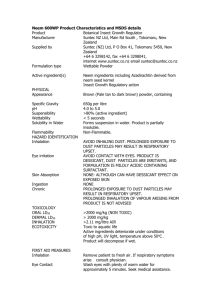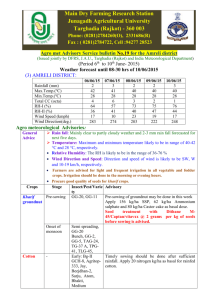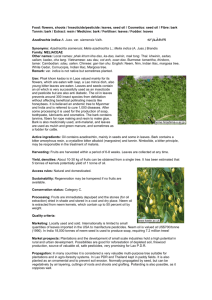Asian Journal of Agricultural Sciences 3(5): 414-416, 2011 ISSN:
advertisement
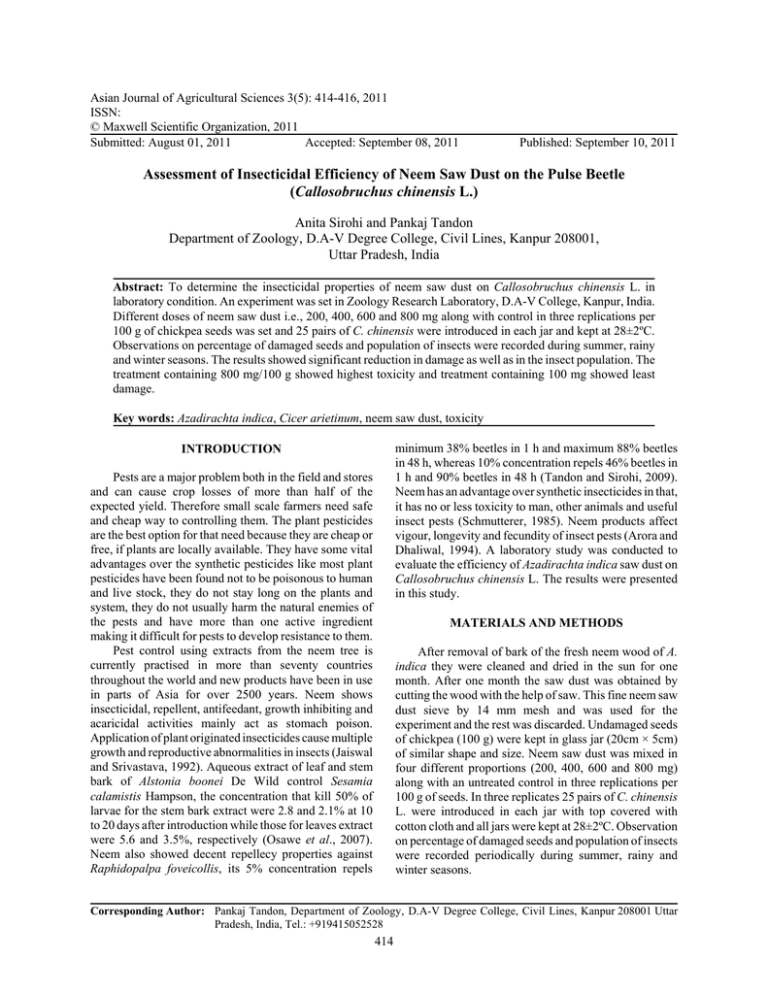
Asian Journal of Agricultural Sciences 3(5): 414-416, 2011 ISSN: © Maxwell Scientific Organization, 2011 Submitted: August 01, 2011 Accepted: September 08, 2011 Published: September 10, 2011 Assessment of Insecticidal Efficiency of Neem Saw Dust on the Pulse Beetle (Callosobruchus chinensis L.) Anita Sirohi and Pankaj Tandon Department of Zoology, D.A-V Degree College, Civil Lines, Kanpur 208001, Uttar Pradesh, India Abstract: To determine the insecticidal properties of neem saw dust on Callosobruchus chinensis L. in laboratory condition. An experiment was set in Zoology Research Laboratory, D.A-V College, Kanpur, India. Different doses of neem saw dust i.e., 200, 400, 600 and 800 mg along with control in three replications per 100 g of chickpea seeds was set and 25 pairs of C. chinensis were introduced in each jar and kept at 28±2ºC. Observations on percentage of damaged seeds and population of insects were recorded during summer, rainy and winter seasons. The results showed significant reduction in damage as well as in the insect population. The treatment containing 800 mg/100 g showed highest toxicity and treatment containing 100 mg showed least damage. Key words: Azadirachta indica, Cicer arietinum, neem saw dust, toxicity minimum 38% beetles in 1 h and maximum 88% beetles in 48 h, whereas 10% concentration repels 46% beetles in 1 h and 90% beetles in 48 h (Tandon and Sirohi, 2009). Neem has an advantage over synthetic insecticides in that, it has no or less toxicity to man, other animals and useful insect pests (Schmutterer, 1985). Neem products affect vigour, longevity and fecundity of insect pests (Arora and Dhaliwal, 1994). A laboratory study was conducted to evaluate the efficiency of Azadirachta indica saw dust on Callosobruchus chinensis L. The results were presented in this study. INTRODUCTION Pests are a major problem both in the field and stores and can cause crop losses of more than half of the expected yield. Therefore small scale farmers need safe and cheap way to controlling them. The plant pesticides are the best option for that need because they are cheap or free, if plants are locally available. They have some vital advantages over the synthetic pesticides like most plant pesticides have been found not to be poisonous to human and live stock, they do not stay long on the plants and system, they do not usually harm the natural enemies of the pests and have more than one active ingredient making it difficult for pests to develop resistance to them. Pest control using extracts from the neem tree is currently practised in more than seventy countries throughout the world and new products have been in use in parts of Asia for over 2500 years. Neem shows insecticidal, repellent, antifeedant, growth inhibiting and acaricidal activities mainly act as stomach poison. Application of plant originated insecticides cause multiple growth and reproductive abnormalities in insects (Jaiswal and Srivastava, 1992). Aqueous extract of leaf and stem bark of Alstonia boonei De Wild control Sesamia calamistis Hampson, the concentration that kill 50% of larvae for the stem bark extract were 2.8 and 2.1% at 10 to 20 days after introduction while those for leaves extract were 5.6 and 3.5%, respectively (Osawe et al., 2007). Neem also showed decent repellecy properties against Raphidopalpa foveicollis, its 5% concentration repels MATERIALS AND METHODS After removal of bark of the fresh neem wood of A. indica they were cleaned and dried in the sun for one month. After one month the saw dust was obtained by cutting the wood with the help of saw. This fine neem saw dust sieve by 14 mm mesh and was used for the experiment and the rest was discarded. Undamaged seeds of chickpea (100 g) were kept in glass jar (20cm × 5cm) of similar shape and size. Neem saw dust was mixed in four different proportions (200, 400, 600 and 800 mg) along with an untreated control in three replications per 100 g of seeds. In three replicates 25 pairs of C. chinensis L. were introduced in each jar with top covered with cotton cloth and all jars were kept at 28±2ºC. Observation on percentage of damaged seeds and population of insects were recorded periodically during summer, rainy and winter seasons. Corresponding Author: Pankaj Tandon, Department of Zoology, D.A-V Degree College, Civil Lines, Kanpur 208001 Uttar Pradesh, India, Tel.: +919415052528 414 Asian J. Agric. Sci., 3(5): 414-416, 2011 70.00 70.00 60.00 60.00 50.00 50.00 40.00 40.00 20.00 20.00 10.00 10.00 0.00 0.00 200 mg 400 mg Loss of seed wt. (Mg) 12.78 600 mg 9.80 800 mg 8.50 200 mg Control 7.80 14.55 400 mg Loss of seed wt. (Mg) 8.55 600 mg 3.35 800 mg 7.90 Control 7.20 11.30 Survival (%) 43.73 38.76 35.64 33.99 49.94 Survival (%) 48.25 44.13 40.48 36.72 49.66 Mortality(%) 56.24 61.22 64.35 66.00 50.05 Mortality(%) 51.74 55.86 59.51 63.27 50.33 Fig. 1: Effect of neem saw dust (in Summer season) on percentage seed loss and mortality of C. chinensis L. when mixed with seeds of C. arietinum Fig. 3: Effect of neem saw dust (in Winter season) on percentage seed loss and mortality of C. chinensis L. when mixed with seeds of C. arietinum 90.00 untreated control, the number of beetles was very high. As far as various doses of different treatments were concerned, the treatment containing 800 mg/00 g of chickpea showed higher toxicity and treatment containing 200 mg showed least toxicity. The most important point is that the mortality response was directly proportional to the increase in dose with the advancement of the time. These studies indicate that if the infestation of the bruchid in this seeds is detected and treatment given in early stages, the germination of seeds may be expected to be as good as in the normal undamaged seeds. Earlier study by Khattak et al. (2001) showed that neem oil at 1000 and 10,000 ppm was good repellent against maize weevils (S. Zeamais Motsch.). The methnol extract of 30 aromatic medicinal plant species and five essential oils was tested for insecticidal activities against adults of S. oryzae (L.) and C. chinensis (L.) using direct contact application and fumigation methods by Soon-II et al. (2003) and found over 90% mortality after one day of treatment for cinnamon oil, horse radish oil and mustard oil. An extract from Cinnamomum sieboldii root bark gave 100% mortality at 2 days after treatment against both the species. This study indicates that the neem saw dust has remarkable properties to protect chickpea from C. chinensis. This plant grows abundantly in India. It is worthwhile to study extensively to control C. chinensis through neem saw dust because it has potential as an alternative to chemical pesticides. 80.00 70.00 60.00 50.00 40.00 20.00 10.00 0.00 200 mg 400 mg 600 mg 800 mg Control Loss of seed wt. (Mg) 17.25 16.40 15.00 13.00 20.80 Survival (%) 75.45 68.44 65.38 62.15 78.24 Mortality(%) 24.54 31.55 34.61 37.84 21.75 Fig. 2: Effect of neem saw dust (in Rainy season) on percentage seed loss and mortality of C. chinensis L. when mixed with seeds of C. arietinum RESULTS AND DISCUSSION The experimental observations have shown that the population growth of the pulse beetle Callosobruchus chinensis (L.) reared on chickpea (Cicer arietinum) after treatment was low and mortality high. In rainy season, the beetles had the tendency to multiply at higher rates and mortality was low. The observational results of the winter season were also significant. Here the population growth of the pulse beetle was also low and mortality high and results obtained is presented in Fig. 1, 2 and 3. In the present experiment after application of neem saw dust of different concentrations, the results showed significant reduction in damage as well as in the insect population in treated grains. It was observed that in REFERENCES Arora, R. and G.S. Dhaliwal, 1994. Botanical Pesticides in Insect Pest Management. In: Dhaliwal, G.S. and B.D. Kansal, (Eds.), Management of Agricultural pollution in India. Common Wealth Publ., New Delhi, India, pp: 213-245. 415 Asian J. Agric. Sci., 3(5): 414-416, 2011 Jaiswal, A.K. and U.S. Srivastava, 1992. Mating disruption in Dysdercus cingulatus caused by Blumea laciniata extracts. J. Appl. Zool. Res., 3: 151-153. Khattak, M.K., A.B. Borce and B. Dover, 2001. Comparative effects of neem or mineral oil on maize weevil, Sitophilus zeamais Motsch. and its parasitoid, Anisopteromalus calandrae (Howard). Online J. Biol. Sci., 1(5): 378-381. Osawe, N.O., B.I. Igho and T. Manuele, 2007. Insecticidal activity of the medicinal pant, Alstonia Boonei De Wild, against Sesamia calamistisii. Schmutterer, H., 1985. Which insect pests can be controlled by application of neem seed kernel extracts under field conditions. Z. Ang. Ent., 100: 468-475. Soon-II, K., R. Jung-Yeon, K. Do-Hyoung, L. Han-Seung and A. Young-Joon, 2003. Insecticidal activities of aromatic plant extracts and essential oils against Sitohilus oryzae and Callosobruchus chinensis. J. Stored Prod. Res., 39(3): 293-303. Tandon, P. and A. Sirohi, 2009. Laboratory assessment of the repellent properties of ethanolic extracts of four plants extracts against Raphidopalpa foveicollis Lucas (Coleoptera: Chrysomelidae). Int. J. Sustain. Crop Prod., 4(2): 1-5. 416
